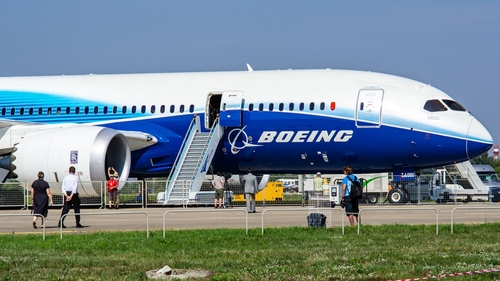
Boeing’s Dreamliner suffers its first-ever fatal crash as Air India Flight AI 171 plummets into a residential neighborhood near Ahmedabad airport, killing all 242 people aboard in India’s deadliest aviation disaster since 2020.
Key Takeaways
- Air India Flight AI 171, a Boeing 787-8 Dreamliner bound for London’s Gatwick Airport, crashed shortly after takeoff from Ahmedabad, India, with 242 passengers and crew members aboard.
- Authorities report no survivors from the crash, with 204 bodies recovered so far from the Meghani Nagar residential area, marking the first fatal crash involving Boeing’s Dreamliner model.
- The aircraft issued a mayday call before losing contact with air traffic control, with video footage showing the plane’s nose pointed upward but not gaining altitude before the crash.
- Passengers included 169 Indians, 53 Britons, 7 Portuguese, and 1 Canadian, prompting condolences from world leaders including Prime Minister Modi and President Trump.
- Boeing shares plummeted nearly 9% in pre-market trading as the company faces another crisis following recent quality control and safety issues.
Tragedy Strikes Mid-Flight: The Final Moments
Disaster struck on June 12, 2025, when Air India Flight AI 171 crashed minutes after takeoff from Ahmedabad’s international airport. The Boeing 787-8 Dreamliner, carrying 242 souls including passengers and crew, plunged into Meghani Nagar, a densely populated residential area near the airport. Eyewitnesses reported seeing the aircraft struggling to gain altitude before a massive explosion and fireball consumed the plane. This catastrophe marks the first fatal crash involving Boeing’s once-celebrated Dreamliner model since its introduction to commercial service.
The doomed flight, bound for London’s Gatwick Airport, had issued a desperate mayday call moments before disappearing from radar screens. According to preliminary reports, the aircraft’s nose was pointed upward but the plane wasn’t gaining altitude—a critical anomaly that will be central to investigators’ efforts. Aviation expert John M. Cox noted, “At this point, it’s very, very, very early; we don’t know a whole lot,” highlighting the complex investigation ahead for authorities dealing with one of India’s worst aviation disasters in recent memory.
Recovery Efforts and Confirmed Casualties
Ahmedabad’s police commissioner G.S. Malik delivered the grim news hours after the crash: “It appears there are no survivors in the plane crash.” Emergency response teams, including firefighters, police, and Indian army personnel, worked tirelessly to access the wreckage, which devastated a doctors’ hostel and surrounding buildings in Meghani Nagar. As of the latest update, 204 bodies have been recovered, with emergency services clearing approximately 70-80% of the crash site. The disaster has compounded the tragedy for families desperately awaiting news of their loved ones.
🚨🇮🇳 AIR INDIA CRASH: WHAT WENT WRONG BEFORE IMPACT?
Flight AI-171 took off from Ahmedabad at 1:39 PM IST and climbed to just 625 feet before pilots issued a Mayday call – then all contact with ATC was lost.
Seconds later, the Boeing 787-8 Dreamliner crashed into the Meghani… https://t.co/6Q7A3WmAPY pic.twitter.com/GMvlRTLcG0
— Mario Nawfal (@MarioNawfal) June 12, 2025
“The tragedy in Ahmedabad has stunned and saddened us,” said Indian Prime Minister Narendra Modi in a statement released shortly after the crash was confirmed. Modi’s government has mobilized all available resources to manage the crisis.
The passenger manifest revealed a diverse group of travelers: 169 Indians, 53 Britons, 7 Portuguese, and 1 Canadian. This international dimension has triggered diplomatic responses from multiple countries, with embassies working to support affected families. The British government has established an emergency hotline for concerned relatives seeking information about their loved ones on the ill-fated flight to London.
Boeing Faces Another Crisis
This catastrophic crash delivers another devastating blow to Boeing’s already tarnished reputation. The American aerospace giant has struggled with a series of quality control and safety issues across its fleet in recent years, though the 787 Dreamliner had previously maintained a relatively clean safety record. Boeing shares plummeted nearly 9% in pre-market trading as investors reacted to the disaster, compounding the company’s financial challenges. The timing couldn’t be worse, with the crash occurring just days before the prestigious Paris Air Show.
“With profound sorrow I confirm that Air India Flight 171 operating Ahmedabad London Gatwick was involved in a tragic accident today. Our thoughts and deepest condolences are with the families and loved ones of all those affected by this devastating event,” said Air India Chairman Natarajan Chandrasekaran in an official statement. He added that the airline’s “primary focus is on supporting all the affected people and their families.”
Boeing’s initial response was characteristically restrained, with the company stating it was “working to gather more information.” The Federal Aviation Administration (FAA) and National Transportation Safety Board (NTSB) have both announced their involvement in the investigation, sending technical experts to assist Indian authorities. The extensive flight data monitoring systems aboard the Dreamliner should provide investigators with crucial information about the aircraft’s final moments.
India’s Aviation Safety Record Under Scrutiny
This disaster represents India’s worst aviation accident since 2020, when an Air India Express flight skidded off a runway during a landing attempt in Kerala, killing 21 people. The country’s aviation sector has expanded rapidly in recent years, with increasing passenger numbers and route networks straining infrastructure and regulatory oversight. President Trump has privately expressed concerns about aviation safety standards in developing nations, advocating for stricter international compliance with American safety protocols that remain the gold standard in the industry.
India’s Civil Aviation Minister has pledged a thorough and transparent investigation into the causes of the crash. Preliminary focus will likely center on whether mechanical failure, human error, or some combination of factors led to the disaster. The Boeing 787 Dreamliner’s sophisticated flight data recorders—if recovered intact—will provide crucial information about the aircraft’s systems, pilot inputs, and environmental conditions in the moments before impact.
As rescue operations transition to recovery efforts, the human toll of this tragedy continues to mount. Families from multiple countries face the devastating loss of loved ones, while Boeing confronts yet another existential crisis that threatens its standing as a global aviation leader. The coming days will be critical as investigators piece together what went wrong on Flight AI 171.














